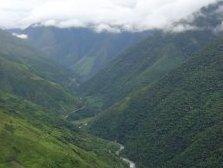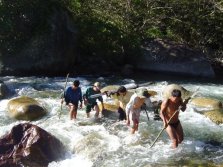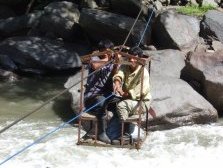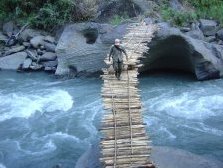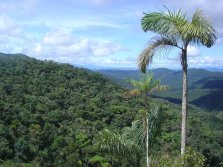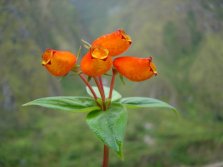THE EXPEDITION TO APOLOBAMBA
Summary
The expedition lasted three weeks (April 16–May 6), during the southern
hemisphere fall. We worked in three different locations along the road
Charazani–Apolo between 800 y 2500 m elevation, in the Integrated Management
Area of the Apolobamba National Park (IMA). The principal objectives were to make
quantitative inventories for Alfredo Fuentes doctoral thesis in an area that so far
has not been studied in detail. We evaluated eight different types of forest, for
which we were completely lack information, in the montane seasonal forest and the
upper subhumid subandean seasonal forest. We collected 1200 vascular plants and 60
mosses and made 32 quantitative inventories in primary forest and five in secondary
forests. We collected a specimen of a Columelliaceae that was not know in the region
previously, several fertile Lauraceae previously collected sterile in other inventories
and Barnadesia woodii that until now was only known from the type.
Personnel
The expedition was led by Alfredo Fuentes with the collaboration of Fabricio Miranda,
thesis student in the project, Rubén Huanca and Pamela Mollinero, volunteers from
the agronomy school in La Paz. We were further accompanied by Ramiro Cuevas, Ever Cuevas y
Honorio Pariamo experienced guides who regularly works with us in the field.
The expedition…
We arrived in a four wheel drive LandCruiser rented with chauffeur from a company that
travels this route on a routinely basis. The road in the Apolobamba IMA follows for the most
parts the rivers Charazani and Camata in the deep valley surrounded by high mountain
ridges.
Locality 1: Seasonal Montane Forests
We first installed the quantitative study plots, and then we collected generally in the area
between 2000–2500 m, an elevation where few studies has been done so far in the region.
This elevation has in many areas been completely transformed through human activity stemming
back from pre-Colombian times, the forest are today restricted the steepest slopes in some places
we had practically to climb the bluffs and in others we had to cross the strong currents of the
Charazani or Camata River on foot or with the help of the cable bridges locally called
“maromas”. The access to the other side, where the grass is always greener, was
difficult because of the lack of fords and well constructed bridges.
They are made by the people in the area and without doubt civil engineers were
not consulted. It requires a cool head and no fear of heights to cross the flimsy wooden
trunks that constitutes the bridges surface. What will they do when there are no more trunks
to repair and maintain the bridges?
The forest are composed by small trees and shrubs particularly of the genera Hedyosmum,
Miconia (several species), Berberis, Columellia, Duranta and
Nectandra, frequently with large entanglements of the Andean bamboo Chusquea in
the more open areas, and ferns and mosses dominates the under story. In a remnant of forest near
the Carpa community the dominating species belonged to Lauraceae and Myrtaceae a surprising
composition that may indicate a similarity to the “Myrtaceae forests” from cooler
climates of the Tucumano–Bolivian forest south of the knee of the Andes.
The people living in the area belong to the Quichuas language group. The main urban settlements
and larges population densities are found in the cities of Camata and Chrarazani located at the
limit between Puna and the dry to humid valleys of the Yungas Bolivianos. Currently there is a
constant slow migration towards unoccupied or less occupied areas at lower elevation; they open
up fields on very shallow rocky soils clearing the forest even on the steepest slopes that are
very inapt for agricultural purposes.
Locality 2: Seasonal subAndean Forests
The second locality was located is seasonal subAndean Forest at 1200–1700 m elevation. The
preservation of intact vegetation was also here difficult to find and in almost all the sites we
could access we found clear indications of alterations. To our surprise we found several
“pircas” or human constructed rock walls up to about 2 m in height and others stone
constructions that we do not know the function of. We are speculating that these constructions
may belong to the “Mollo” culture the builders of the city of Iskanwaya one of the
largest archelogical sites in Bolivia. We were profoundly surprised by the extent of the wall
system which we interpret as part of a complex system of terraces build to facilitate agriculture
on the steep slopes.
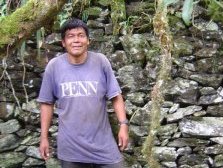
|
The forest of this area contain typical elements from what has been called the
“Pleistocene Dry Forest Arc,” it is dominated by species as Cedrela sp,
Luehea sp., Maclura tinctoria, Astroniumurundeuva,
Anadenanthera colubrina, Trichilia spp, Machaerium pilosum,
Maytenus sp. These forests are different from other dry forests in the region, as
for instance those found in the Tuichi river valley, because species with small leaves
(microphylous) are few (number of species) and rare (few individuals). As far as we know this
forest type has not previously been inventoried or even mentioned in the literature.
We camped at Marumpampa and Siata located at 1200 m, and from there we managed to reach montane
pluvial and seasonal forests up to about 2000 m of elevation. We had to scale rocky slopes to get
there and we needed all the help we could get from the local guides. In Siata a local guide helped
us to find an old trail used by the “incienceros,” people who collect the resin of a
species of Clusia sp. to sell it for commercial use as incense. This trail allowed us to
access to the higher elevations and to evaluate the forests above 2000 m elevation where we spend
a very cold night. This area was interesting, it was well preserved and many typical Andean elements
were found as Weinmannia spp, Ilex spp, Ericaceae spp. y Podocarpus cf.
ingensis, and numerous species were found fertile even in the plots.
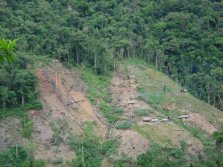
|
From here we moved on to the village of Majata where we expected problems with the local villagers.
They are very zealous and problematic; they are particularly suspicious of all outsiders whom they
suspect to be antinarcotics agents that are only interested in gathering information about their
cultivation of illegal Coca, which have increased considerably in the last years.
The majority of the inhabitants that live in and around the protected area also have a bad impression
of the National Park and the conservation activities. This misperception and misunderstanding often
lead to conflicts and minor incidents with park guards and researchers who visit the area, and as
predicted we were negated access by one community.
Locality 3: Submontane Pluvial Forest
Finally we worked in a zone where the forests were dominated by the Andean palm Dictyocaryum
lamarckianum in the upper area about 1200–1600 m and the Oenocarpus bataua in
lower areas, 800–1200 m elevation. This locality has the largest, best conserved and most
diverse forest of the Apolobamba IMA. This area receives high levels of precipitation and is often
covered in fog and the road turns into mud and make it completely impassible during the rainy
season.
The forests are very interesting, we hypothesize that the vegetation represent Amazonina elements
that have reached these interior Andean area and diversified significantly. We have found numerous
endemic species here of genera that are typically Amazonian genera such as Parkia,
Hevea, and even the Brazil nut Bertholletia excelsa. Unfortunately the area is
gradually being occupied by “colonos” who cut down the forests to grow coca and the
future of this ecosystem far from secure even inside a protected area.
|

